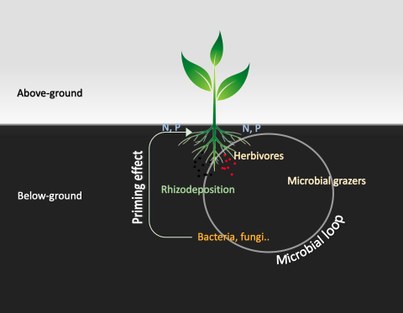Micro- and mesofauna - microflora - plant interactions: extending the soil “microbial loop concept” of nutrient cycling and plant growth
Soil protists and nematodes play a significant role in the process of organic matter decomposition and nutrient dynamics because of their diversified feeding behavior and their direct and indirect regulation of the activities of the primary decomposers (bacteria + fungi). The ‘Microbial loop’, which has been considered as a main underlying mechanism for increased N mineralization in the rhizosphere suggests that carbon-rich root exudates stimulate the growth of bacteria, which are normally C-limited. The microfauna grazes on the bacterial biomass and subsequently releases the immobilized N, thus making available the N for plants which otherwise would have been locked up in the microbial biomass. While this much cited ‘microbial loop’ hypothesis was originally proposed for protists, it could be even more valid for nematodes. Indeed, studies have demonstrated that a small infestation by herbivorous nematodes increases root exudation that fuels microbial growth and activity. Like protists, microbivorous nematodes graze on the microbes and excrete the excess N in the same way, as hypothesized for protists in the microbial loop. We hypothesize that low-level infestation by plant-parasitic nematodes (PPNs) fuels the microbial loop via increased microbial biomass and activity as a result of increased rhizodeposition. We aim to extend the microbial loop concept to all four main players in rhizosphere nutrient dynamics (microbes, protists, nematodes, and plants). This would be the first experiment to study how C and N cycling is influenced by PPNs in a model system that allows interactions between bacteria, bacterivorous protists, and nematodes. This PhD project comprises two mesocosm and a microcosm experiments, first: developing a methodology to recover soil microbial community structure and activity by selective removal and reinoculation of soil micro and mesofauna; second: quantifying the contribution of fungivorous, bacterivorous and herbivorous soil mesofauna to nutrient mineralization/availability and plant, and third: quantifying the composition of rhizodeposition by herbivory nematodes and their effects on nutrient mineralization and plant growth. The changes of microbial community structure (PLFA, qPCR), activities (enzymes), microbial biomass C and N, nitrification (NO3- and NH4+), soil fauna (microscopy, DNA/RNA), plant nutrient uptake (N, P), rhizo-deposited C (tracing labelled 13C) will be measured to identify the underlying mechanisms
